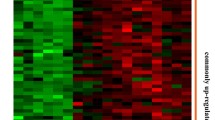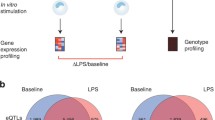Abstract
Several genome-wide transcriptome studies have shown that chronic inflammatory responses generally taking place in the inflamed tissue are also reflected at the level of peripheral blood leukocytes. Blood monocytes are highly sensitized cell type continuously activated under inflammatory conditions. For a better understanding of the transcriptional imprinting influenced by a multitude of pro- and anti-inflammatory mediators, we established a whole blood in vitro system to explore cell- and stimulus-specific gene expression signatures in peripheral monocytes. In an explorative study, whole blood from healthy donors was stimulated with tumour necrosis factor-alpha (TNF-α) or lipopolysaccharide (LPS) for 1.5 h. Subsequently, monocytes were isolated with a purity of >99% by high-speed fluorescence activated cell sorting. Transcriptional changes were explored by whole genome Affymetrix arrays using highly validated filtering algorithm to identify differentially expressed genes. In vitro stimulation of whole blood samples with TNF-α and LPS resulted in 4,529 and 5,036 differentially expressed genes, respectively. Although both stimuli induced similar inflammatory profiles in monocytes, TNF-α- or LPS-specific gene signatures were characterized. Functional classification identified significant numbers of differentially expressed cytokines, cytokine receptors and apoptosis-associated genes. To our knowledge, this is the first study presenting cell- and stimulus-specific gene expression signatures that can be used to decipher complex disease specific profiles of acute and chronic inflammation. Once a library of signatures from the most important inflammatory mediators is defined, it can be helpful to identify those signatures, which are predominantly driving the disease pathogenesis and which are of potential interest for a therapeutical intervention.










Similar content being viewed by others
References
Marrack P, Kappler J, Kotzin BL (2001) Autoimmune disease: why and where it occurs. Nat Med 7:899–905. doi:10.1038/90935
Veale DJ, Ritchlin C, FitzGerald O (2005) Immunopathology of psoriasis and psoriatic arthritis. Ann Rheum Dis 64(Suppl 2):ii26–ii29. doi:10.1136/ard.2004.031740
Batliwalla FM, Baechler EC, Xiao X, Li W, Balasubramanian S, Khalili H, Damle A, Ortmann WA, Perrone A, Kantor AB, Gulko PS, Kern M, Furie R, Behrens TW, Gregersen PK (2005) Peripheral blood gene expression profiling in rheumatoid arthritis. Genes Immun 6:388–397
Batliwalla FM, Li W, Ritchlin CT, Xiao X, Brenner M, Laragione T, Shao T, Durham R, Kemshetti S, Schwarz E, Coe R, Kern M, Baechler EC, Behrens TW, Gregersen PK, Gulko PS (2005) Microarray analyses of peripheral blood cells identifies unique gene expression signature in psoriatic arthritis. Mol Med 11:21–29
Stoeckman AK, Baechler EC, Ortmann WA, Behrens TW, Michet CJ, Peterson EJ (2006) A distinct inflammatory gene expression profile in patients with psoriatic arthritis. Genes Immun 7:583–591. doi:10.1038/sj.gene.6364334
Baechler EC, Bauer JW, Slattery CA, Ortmann WA, Espe KJ, Novitzke J, Ytterberg SR, Gregersen PK, Behrens TW, Reed AM (2007) An interferon signature in the peripheral blood of dermatomyositis patients is associated with disease activity. Mol Med 13:59–68
Baechler EC, Batliwalla FM, Karypis G, Gaffney PM, Ortmann WA, Espe KJ, Shark KB, Grande WJ, Hughes KM, Kapur V, Gregersen PK, Behrens TW (2003) Interferon-inducible gene expression signature in peripheral blood cells of patients with severe lupus. Proc Natl Acad Sci USA 100:2610–2615
Maas K, Chan S, Parker J, Slater A, Moore J, Olsen N, Aune TM (2002) Cutting edge: molecular portrait of human autoimmune disease. J Immunol 169:5–9
Lock C, Hermans G, Pedotti R, Brendolan A, Schadt E, Garren H, Langer-Gould A, Strober S, Cannella B, Allard J, Klonowski P, Austin A, Lad N, Kaminski N, Galli SJ, Oksenberg JR, Raine CS, Heller R, Steinman L (2002) Gene-microarray analysis of multiple sclerosis lesions yields new targets validated in autoimmune encephalomyelitis. Nat Med 8:500–508. doi:10.1038/nm0502-500
Häupl T, Ostensen M, Grützkau A, Burmester GR, Villiger PM (2008) Interaction between rheumatoid arthritis and pregnancy: correlation of molecular data with clinical disease activity measures. Rheumatology Oxford 47(Suppl 3):iii19–iii22. doi:10.1093/rheumatology/ken157
Häupl T, Ostensen M, Grützkau A, Radbruch A, Burmester GR, Villiger PM (2008) Reactivation of rheumatoid arthritis after pregnancy: increased phagocyte and recurring lymphocyte gene activity. Arthritis Rheum 58:2981–2992. doi:10.1002/art.23907
Grützkau A, Grün J, Häupl T, Burmester GR, Radbruch A (2007) Gene expression in inflammatory rheumatic diseases. Dtsch Med Wochenschr 132:1888–1891
van der Pouw Kraan TC, Wijbrandts CA, van Baarsen LG, Voskuyl AE, Rustenburg F, Baggen JM, Ibrahim SM, Fero M, Dijkmans BA, Tak PP, Verweij CL (2007) Rheumatoid arthritis subtypes identified by genomic profiling of peripheral blood cells: assignment of a type I interferon signature in a subpopulation of patients. Ann Rheum Dis 66:1008–1014. doi:10.1136/ard.2006.063412
Clark IA (2007) How TNF was recognized as a key mechanism of disease. Cytokine Growth Factor Rev 18:335–343. doi:10.1016/j.cytogfr.2007.04.002
McInnes IB, Schett G (2007) Cytokines in the pathogenesis of rheumatoid arthritis. Nat Rev Immunol 7:429–442
Rigby WF (2007) Drug insight: different mechanisms of action of tumor necrosis factor antagonists-passive-aggressive behavior? Nat Clin Pract Rheumatol 3:227–233
Catrina AI, Trollmo C, af Klint E, Engstrom M, Lampa J, Hermansson Y, Klareskog L, Ulfgren AK (2005) Evidence that anti-tumor necrosis factor therapy with both etanercept and infliximab induces apoptosis in macrophages, but not lymphocytes, in rheumatoid arthritis joints: extended report. Arthritis Rheum 52:61–72. doi:10.1002/art.20764
Kinne RW, Brauer R, Stuhlmuller B, Palombo-Kinne E, Burmester GR (2000) Macrophages in rheumatoid arthritis. Arthritis Res 2:189–202
Taylor PC, Williams RO, Feldmann M (2004) Tumour necrosis factor alpha as a therapeutic target for immune-mediated inflammatory diseases. Curr Opin Biotechnol 15:557–563. doi:10.1016/j.copbio.2004.09.005
Biesen R, Demir C, Barkhudarova F, Grün JR, Steinbrich-Zollner M, Backhaus M, Häupl T, Rudwaleit M, Riemekasten G, Radbruch A, Hiepe F, Burmester GR, Grützkau A (2008) Sialic acid-binding Ig-like lectin 1 expression in inflammatory and resident monocytes is a potential biomarker for monitoring disease activity and success of therapy in systemic lupus erythematosus. Arthritis Rheum 58:1136–1145. doi:10.1002/art.23404
Menßen A, Edinger G, Grün J, Haase U, Baumgrass R, Grützkau A, Radbruch A, Burmester G, Häupl T (2009) SiPaGene: a new repository for instant online retrieval, sharing and meta-analyses of GeneChip® expression data. BMC Genomics 10:98
Califano A, Stolovitzky G, Tu Y (2000) Analysis of gene expression microarrays for phenotype classification. Proc Int Conf Intell Syst Mol Biol 8:75–85
Stühlmuller B, Häupl T, Hernandez MM, Grützkau A, Kuban RJ, Tandon N, Voss JW, Salfeld J, Kinne RW, Burmester GR (2010) CD11c as a transcriptional biomarker to predict response to anti-TNF monotherapy with adalimumab in patients with rheumatoid arthritis. Clin Pharmacol Ther 87:311–321. doi:10.1038/clpt.2009.244
Dennis G Jr, Sherman BT, Hosack DA, Yang J, Gao W, Lane HC, Lempicki RA (2003) DAVID: database for annotation, visualization, and integrated discovery. Genome Biol 4:P3
Dinarello CA (1998) Interleukin-1 beta, interleukin-18, and the interleukin-1 beta converting enzyme. Ann NY Acad Sci 856:1–11
Barksby HE, Lea SR, Preshaw PM, Taylor JJ (2007) The expanding family of interleukin-1 cytokines and their role in destructive inflammatory disorders. Clin Exp Immunol 149:217–225. doi:10.1111/j.1365-2249.2007.03441.x
Balabanian K, Lagane B, Infantino S, Chow KY, Harriague J, Moepps B, Arenzana-Seisdedos F, Thelen M, Bachelerie F (2005) The chemokine SDF-1/CXCL12 binds to and signals through the orphan receptor RDC1 in T lymphocytes. J Biol Chem 280:35760–35766. doi:10.1074/jbc.M508234200
Zlotnik A, Yoshie O, Nomiyama H (2006) The chemokine and chemokine receptor superfamilies and their molecular evolution. Genome Biol 7:243
Grützkau A, Radbruch A (2008) Separation of whole blood cells and its impact on gene expression. In: GB BA (ed) Microarrays in inflammation. Basel, Birkhaeuser Verlag AG, pp 31–40
Wahl LM, Wahl SM, Smythies LE, Smith PD (2006) Isolation of human monocyte populations. Curr Protoc Immunol chapter 7: Unit 7 6A. doi 10.1002/0471142735.im0706as70
Tracey D, Klareskog L, Sasso EH, Salfeld JG, Tak PP (2008) Tumor necrosis factor antagonist mechanisms of action: a comprehensive review. Pharmacol Ther 117:244–279. doi:10.1016/j.pharmthera.2007.10.001
Ulloa L, Tracey KJ (2005) The “cytokine profile”: a code for sepsis. Trends Mol Med 11:56–63. doi:10.1016/j.molmed.2004.12.007
Baud V, Karin M (2001) Signal transduction by tumor necrosis factor and its relatives. Trends Cell Biol 11:372–377.
Baccala R, Hoebe K, Kono DH, Beutler B, Theofilopoulos AN (2007) TLR-dependent and TLR-independent pathways of type I interferon induction in systemic autoimmunity. Nat Med 13:543–551. doi:10.1038/nm1590
Palucka AK, Blanck JP, Bennett L, Pascual V, Banchereau J (2005) Cross-regulation of TNF and IFN-alpha in autoimmune diseases. Proc Natl Acad Sci USA 102:3372–3377. doi:10.1073/pnas.0408506102
Banchereau J, Pascual V (2006) Type I interferon in systemic lupus erythematosus and other autoimmune diseases. Immunity 25:383–392. doi:10.1016/j.immuni.2006.08.010
Bennett L, Palucka AK, Arce E, Cantrell V, Borvak J, Banchereau J, Pascual V (2003) Interferon and granulopoiesis signatures in systemic lupus erythematosus blood. J Exp Med 197:711–723
Hotchkiss RS, Nicholson DW (2006) Apoptosis and caspases regulate death and inflammation in sepsis. Nat Rev Immunol 6:813–822. doi:10.1038/nri1943
Acknowledgments
We are grateful to Heidi Schliemann responsible for generating gene expression data. The work was supported by the German Ministry of Education and Research (BMBF) within the National Genome Research Network NGFN (01GS0413) and by the European Union’s Sixth Framework Programme (project AutoCure; LSHB-CT-2006-018861).
Disclosure of potential conflict of interests
The authors declare no conflict of interests related to this study.
Author information
Authors and Affiliations
Corresponding author
Additional information
Author Contributions
Conceived and designed the experiments: AG, GRB, RB, AR. Performed the experiments: BSm, AG. Analyzed the data: BSm, AG, JG, TH, BSt, MSZ. Wrote the paper: BSm, AG, RB, JG.
Andreas Grützkau and Ria Baumgrass contributed equally to this work
Supported by the German Federal Ministry of Education and Research (BMBF) through the National Genome Research Network (Infection and Inflammation Network SIPAGE, grant 01GS0413) and by the European Union's Sixth Framework Programme (project AutoCure; LSHB-CT-2006-018861)
Electronic supplementary material
Below is the link to the electronic supplementary material.
Supplementary File 1
This file includes a description how to get access to the publically available array data using BioRetis database. Furthermore, filtering criteria are described for the selection of differentially expressed genes. (PDF 15 kb)
Supplementary Table 1
with sheet 1-9. These tables include Signal values, p values, Signal Log Ratio (SLR), Fold Change (FC) of differentially expressed probe sets that distinguish unstimulated monocytes but incubated, TNF-α- and LPS-stimulated monocytes from Unstimulated and immediately processed monocytes. (XLS 8343 kb)
Supplementary Table 2
with sheet 1-3. These tables include the probe sets that discriminate TNF-α- from LPS-stimulated monocytes. Beside 1,824 probe sets that are TNF-α specific and 3,214 probe sets specific for LPS, there are 94 probe sets that are common for TNF and LPS stimulation but they are regulated in opposite direction by these two stimuli. (XLS 789 kb)
Supplementary Table 3
with sheet 1-2. These tables include the probe sets that describe the cytokine–cytokine receptor profile in monocytes. Altogether 182 probe sets are differentially expressed in monocytes stimulated with TNF-α or LPS for 1.5 h compared with unstimulated cells. 120 genes out of 182 probe sets that are differentially expressed are presented with average signals and average fold changes. (XLS 80 kb)
Supplementary Table 4
with sheet 1-2. These tables include the probe sets of the genes that describe the apoptosis-survival profile in monocytes. Altogether 419 probe sets are differentially expressed and involved in apoptosis and survival in monocytes after 1.5 h of incubation in the presence of TNF-α or LPS compared with unstimulated cells. 240 genes out of 419 differentially expressed probe sets were presented with average signals and average fold changes. (XLS 163 kb)
Supplementary Table 5
with sheet 1-3. These tables include Signal values, p values, Signal Log Ratio (SLR), Fold Change (FC) of 471 differentially expressed probe sets that distinguish monocytes from RA patients that responded to anti-TNF-α therapy, before and after treatment (sheet 1 and 2). These probe sets were revealed as significantly increased or decreased in 80% of pair-wise comparisons. Sheet 3 includes 179 probe sets with FC that are common for in vitro stimulated monocytes by TNF-α and monocytes from RA patients treated with anti-TNF-α, and which showed opposite direction of changes. Affymetrix arrays used for analysis of in vitro stimulated monocytes belong to HG-U133 Plus 2.0 platform and for analysis of anti-TNF treated RA patients to HG-U133A 2.0. (XLS 287 kb)
Rights and permissions
About this article
Cite this article
Smiljanovic, B., Grün, J.R., Steinbrich-Zöllner, M. et al. Defining TNF-α- and LPS-induced gene signatures in monocytes to unravel the complexity of peripheral blood transcriptomes in health and disease. J Mol Med 88, 1065–1079 (2010). https://doi.org/10.1007/s00109-010-0648-8
Received:
Revised:
Accepted:
Published:
Issue Date:
DOI: https://doi.org/10.1007/s00109-010-0648-8




